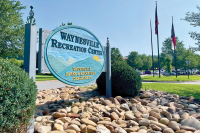Toxic plants of Appalachia
 George Ellison.
George Ellison.
From time to time, I’ve discussed in this space various plants the Cherokees and early settlers utilized for medicinal, edible and utilitarian purposes. The reverse side of that topic would be those plants that were dangerous to use.
The most dangerous would have been some of the poisonous mushrooms found in the genus “Amanita.” Species in this genus like the so-called destroying angel (A. verna) are especially difficult to treat because they're delayed in reaction. Symptoms do not usually appear for at least six hours and death occurs as long as 10 days later.
Most white settlers here in the Smokies region avoided mushrooms like the plague. This was because their ancestors arriving here in America had found and ingested mushrooms that were deadly look-a-likes for species they had safely eaten in Europe. On the other hand, many Cherokees still gather and eat mushrooms with gusto. Through the years, they have learned by trial and error the species that are to be avoided.
Other highly toxic plants in this region include climbing nightshade (Solanum dulcamara), dolls’-eyes (Actaea pachypoda), false hellebore (Veratrum viride and V. parviflorum), jimsonweed (Datura stramonium), and May-apple or American mandrake (Podophyllum peltatum).
When leading tree identification workshops, I like to name and discuss the conifers as encountered. They are relatively few in number and easy to learn. After we’ve encountered our first eastern hemlock (Tsuga candadensis), someone in the group always asks, “Isn’t hemlock poisonous?” Or the person might simply declare: “Hemlock trees are deadly poisonous, you know.”
He or she will, of course, have in mind the fact that the Greek philosopher Socrates was reported to have committed suicide in 399 B.C. by ingesting a solution made from poison hemlock. I have to explain that hemlock trees aren’t toxic in the least. The poison hemlock they are referring to is in reality an herbaceous species in the carrot family that bears the scientific name “Conium maculatum.”
Related Items
I recently encountered large stands of the plant along the north bank of the Tuckaseigee River just west of Bryson City. Its finely-dissected leaves and purple-spotted stems are diagnostic. Nevertheless, novice wild food foragers hoping to gather the edible rootstocks of Queen Anne’s lace (wild carrot) sometimes slip up and harvest poison hemlock instead. Wannabe foragers can also mistake the finely dissected leaves of the young plants for parsley, or the seeds for anise. Such errors inevitably result in a trip to an emergency room and, sometimes, even to the cemetery.
In Common Poisonous Plants and Mushrooms of North America (Timber Press, 1991) by Nancy J. Turner and Adam F. Szczawinski, the authors note that “poison hemlock contains a group of closely related poisonous alkaloids” that “are structurally related to nicotine, and act similarly, producing initial stimulation followed by severe depression of the central nervous system, resulting in paralysis, slowing of the heart, convulsions, and death from respiratory paralysis. All parts of the plant are toxic, especially the leaves before flowering, and the flowers and fruits ... The plant is known to be toxic to both humans and animals, and has often produced fatalities.”
In Medicinal Plants (James C. Yorston & Co., 1982), Charles F. Millspaugh observes that “the history of this fetid, poisonous plant dates back to about the fifth century before Christ. From the careful observations of many historians, there seems little doubt that the Grecian state potion used at Athens as a mode of execution of those condemned to death by the tribunal of Areopagus, was principally, if not wholly, composed of the fresh juice of the leaves and green seeds of this plant.”
Millspaugh excerpts from Plato’s “Phaedo” the description of Socrates’ death: “And Crito, hearing this, gave the sign to the boy who stood near; and the boy departing, after some time returned, bringing with him the man who was to administer the poison, who brought it readily bruised in a cup. And Socrates, beholding the man, said: ‘Good friend, come hither; you are experienced in these affairs — what is to be done?' ‘Nothing,’ replied the man, only when you have drank the poison you are to walk about until a heaviness takes place in your legs; then lie down — this is all you have to do.’”
Yes, indeed, just one little mistake with some of the plants mentioned above will be “all you have to do.”
Editor’s note: this column first appeared in a June 2003 issue of The Smoky Mountain News.
(George Ellison is a writer and naturalist who lives in Bryson City. This email address is being protected from spambots. You need JavaScript enabled to view it..)









